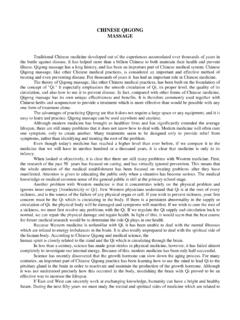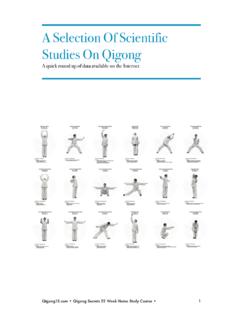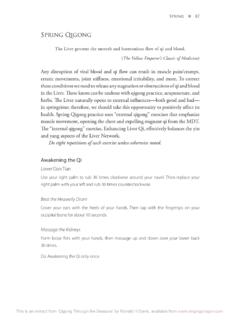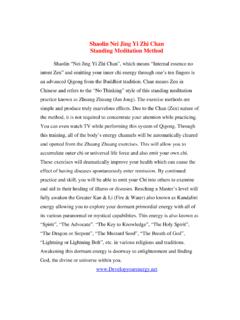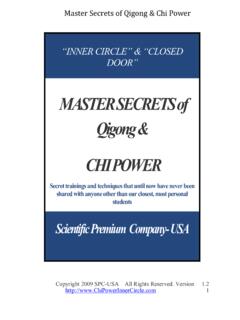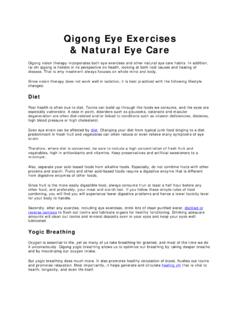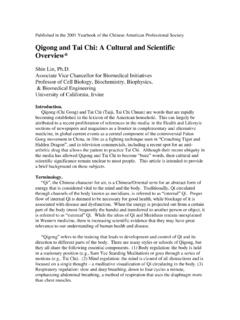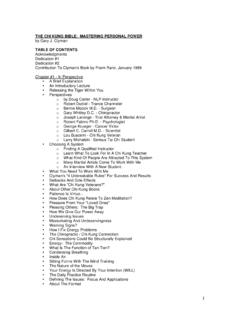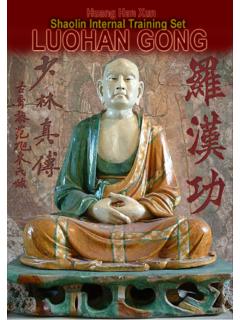Transcription of QongIg - Qigong Dharma
1 70 T R I C YC L E s u m m e r 2 0 1 1By Teja BellPhotographs by Stephanie Mohan | Diagrams by Mason HolcombI began the practice of meditation at the age of 15 during my martial arts training, which began over 40 years ago. My teacher, Tatsumo Makami, would sit us in seiza (kneeling) posture for a few minutes before class. He seemed to take delight in straightening my back, adjusting my head, and trying to slow my breathing down, while my knees ached and my patience waned. I couldn t wait until medita-tion time was over so I could get on to what I thought was the real stuff of martial arts kicks, punches, and throws with loud kiai , as I looked more deeply into my martial arts prac-tice and began studying Asian arts and philosophies from many different cultures and traditions, I began to see that one of the threads interconnecting them all at the highest levels is the practice of stillness and then the practice of stillness in action.
2 Over the decades, meditation has become central to all of my embodiment arts: aikido, yoga, and Chinese martial arts such as taiji, xingyi, bagua, and liuhe-bafa. At the root of all of the Chinese internal martial arts is Qigong the powerful system of energy practices that have in turn supported the expansion and deepening of my medita-tion Chinese word Qigong means energy cultivation. Qi is the universal life-force, and gong is both the action and the result of sustained effort over time. The practice of Qigong honors and cultivates this energy aspect of our being the matrix of life-force that permeates our physical body and thus supports the development of holistic anthropological research suggests that Qigong originated in China around the second millennium , with a well-established later history as part of both Taoist and Buddhist contemplative traditions.
3 Qigong is a complete meditative practice in itself as well as a perfect complement to any other form of meditation. It empowers meditators with calm, clear vitality, strength, and vibrant health bringing peace to the body, heart, and spirit. Wise Qigong practice can reset and balance the nervous system by releasing tension, and softening and lengthening the breath through mindful action. Thus Qigong is really a way to offer metta (lovingkindness) and compassion toward teach a form of Qigong for meditators that I call Radiant Heart Qigong . The benefits of Radiant Heart Qigong practice for meditators are many. To begin with, the forms are acces-sible to almost every fitness level and can (indeed, should) be modified to fit each individual s needs.
4 Qigong may be done while standing, sitting, walking, and even lying down. The ease of performing Qigong belies the transformative power it offers. It is precisely this ease that allows its mindful practice to open the gateway to the direct experience of be-ing a quality that I call presence awareness, which can refer both to an action and to a state of being. As an action, presence awareness is to bring the fullness of our attention to an object the breath, for example, or any feature of the physical or energetic body, the mind, or the emotions. When we rest in presence awareness, we embody a kind of poise of being in which we are present to our interconnectedness with all of life, and our consciousness can rest in its own pristine and unobscured nature.
5 Qigong unifies the domains of our human being spirit, mind, and body. for meditators energy cultivation for a deepened 704/12/11 10:00 PMT R I C YC L E s u m m e r 2 0 1 1 71 714/12/11 10:00 PM72 T R I C YC L E s u m m e r 2 0 1 1 Essential Practice: Standing MeditationThe foundation for the expression of many Qigong actions is the gesture known as standing medita-tion, or wuji posture. (Photo 1; Standing Medita-tion Posture)In the tradition of Qigong , standing meditation plays a central role in the development of the physical, energetic, and spiritual essence of prac-tice. In ancient and contemporary Qigong litera-ture, the refinement of standing meditation in-structions and techniques is often presented as being absolutely essential to understanding and deepening embodiment.
6 For traditional meditators the benefit of cor-rectly learning and practicing standing meditation Qigong is manifold. By paying attention to the in-tegrity of structural alignment, the practitioner improves posture, increases relaxation and ease, and develops what I call field awareness of the body the ability to be holistically aware of the presence of aliveness that we call our body. Begin in a normal upright posture with your feet about shoulder width or a little wider. Let the feet be parallel with the toes pointing forward. The arch should be lightly lifted, with slightly more weight on the outer edge of each foot. For a moment, look down at your feet and compare your subjective feeling of alignment with the the actual physical alignment.
7 Make any subtle adjustments neces-sary; then look up and straight ahead. As your arms rest natu-rally at your sides, bend the elbows slightly to open the space of your present to the sensations of the weight of your body connecting with the surface you are standing on. Sense the three primary energy points on the bottom of your feet, as shown in Diagram 1. Subtly shift your weight between the forward point (K1 in the diagram) slightly in front of the arch and in the center of the foot and the center of the heel point. Sense the center point in the arch that is the balance and stable grounding point of the the knees slightly bent, not locked. Relax the hips and pelvis and let the tailbone settle downward. This action begins to flatten the lower lumbar area, encouraging the body s weight to flow through the legs into the earth.
8 Develop the feeling of connecting with the earth and with the quality of natural, grounded stability. Soften the back of the neck by bringing the chin slightly down and inward, keeping the throat open. This encourages the head to lift gently and the crown to open energetically. Remem-ber, don t strain or stress. Lightly press the back of the crown of the head upward to open and lengthen the cervical vertebrae. This optimizes circulation and energy flow to and from the brain, through the spinal cord and neural soften and relax the jaw and the muscles of the face. Allow the tongue to rest lightly touching the upper palette. Re-lax the jaw and the temporomandibular joint (TMJ), the hinge that connects the lower jaw to the skull.
9 Keep your eyes diagram 2whether open or closed soft and peaceful, with the peripheral vision natural abdominal breathing in a way that releases tension throughout the field of the body. Take time to feel and cultivate these qualities of breath: soft; smooth; even; natural; and deep (but not to maximum capacity aim for the 70 per-cent range).Now sense the energetic centerline that flows through the core of your body. This is like a vertical axis that connects the three dynamic centers of the body the head, the heart (center of the chest), and the hara, or lower dantian. (See Diagram 2) As it is traditionally described, this axis connects heaven and earth with and through the individual human in the middle. Now the physical and energetic being begins to come into alignment, in harmony with itself and the environment.
10 Pres-ence awareness is calm and awake. This alignment and poise is meditation, a state that is also the ground for other forms of contemplative practice. In the standing meditation practice, you may experience a variety of physical and energetic phenomena. Proceed slowly and with patience, beginning with just 3 to 5 minutes and gradually increasing over Body BreathFrom the stillness and stability of the standing meditation pos-ture we open into motion with the Radiant Body Breath. Through this practice, we guide the qi throughout the entire field of the body, smoothing and soothing the energy body while diagram 1 PHoTograPH By Sean o 724/12/11 10:00 PMT R I C YC L E s u m m e r 2 0 1 1 73 deepening and regulating the breath.
